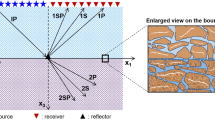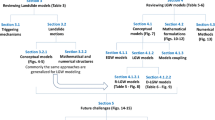Abstract
We put forward a solution to the initial boundary value (IBV) problem for the nonlinear shallow water system in inclined channels of arbitrary cross section by means of the generalized Carrier–Greenspan hodograph transform (Rybkin et al. in J Fluid Mech, 748:416–432, 2014). Since the Carrier–Greenspan transform, while linearizing the shallow water system, seriously entangles the IBV in the hodograph plane, all previous solutions required some restrictive assumptions on the IBV conditions, e.g., zero initial velocity, smallness of boundary conditions. For arbitrary non-breaking initial conditions in the physical space, we present an explicit formula for equivalent IBV conditions in the hodograph plane, which can readily be treated by conventional methods. Our procedure, which we call the method of data projection, is based on the Taylor formula and allows us to reduce the transformed IBV data given on curves in the hodograph plane to the equivalent data on lines. Our method works equally well for any inclined bathymetry (not only plane beaches) and, moreover, is fully analytical for U-shaped bays. Numerical simulations show that our method is very robust and can be used to give express forecasting of tsunami wave inundation in narrow bays and fjords.







Similar content being viewed by others
Notes
We outline the main results here in Introduction. The derivations are given in the main text.
\(\left\| \cdot \right\| \) stands for the Euclidean norm.
References
Alekseenko, S., Dontsova, M., Pelinovsky, D.: Global solutions to the shallow water system with a method of an additional argument. Appl. Anal. 69(9), 1444–1465 (2017)
Anderson, D., Harris, M., Hartle, H., Nicolsky, D., Pelinovsky, E., Raz, A., Rybkin, A.: Run-up of long waves in piecewise sloping u-shaped bays. J. Pure Appl. Geophys. 174, 3185–3207 (2017)
Antuono, M., Brocchini, M.: The boundary value problem for the nonlinear shallow water equations. Stud. Appl. Math. 119, 73–93 (2007)
Antuono, M., Brocchini, M.: Solving the nonlinear shallow-water equations in physical space. J. Fluid Mech. 643, 207–232 (2010)
Carrier, G., Greenspan, H.: Water waves of finite amplitude on a sloping beach. J. Fluid Mech. 01, 97–109 (1958)
Carrier, G., Wu, T., Yeh, H.: Tsunami run-up and draw-down on a plane beach. J. Fluid Mech. 475, 79–99 (2003)
Chugunov, V., Fomin, S., Noland, W., Sagdiev, B.: Tsunami runup on a sloping beach. Comput. Math. Methods 2, e1081 (2020)
Chugunov, V., Fomin, S., Shankar, R.: Influence of underwater barriers on the distribution of tsunami waves. J. Geophys. Res. Oceans 119, 7568–7591 (2014)
Craig, W.: Surface water waves and tsunamis. J. Dyn. Differ. Equ. 18(3), 525–549 (2006)
Craig, W., Groves, M.: Hamiltonian long-wave approximations to the water-wave problem. Wave Motion 19, 367–389 (1994)
Craig, W., Guyenne, P., Kalisch, H.: A new model for large amplitude long internal waves. C. R. Mec. 332, 525–530 (2004)
Craig, W., Guyenne, P., Kalisch, H.: Hamiltonian long wave expansions for free surfaces and interfaces. Commun. Pure Appl. Math. 58(12), 1587–1641 (2005)
Craig, W., Guyenne, P., Nicholls, D., Sulem, C.: Hamiltonian long-wave expansions for water waves over a rough bottom. Proc. R. Soc. Lond. Ser. A 461, 839–873 (2005)
Craig, W., Wayne, C.: Mathematical aspects of surface water waves. Russ. Math. Surv. 62(3), 453–473 (2007)
Didenkulova, I., Pelinovsky, E.: Non-linear wave evolution and run-up in an inclined channel of a parabolic cross-section. Phys. Fluids 23, 086602 (2011)
Didenkulova, I., Pelinovsky, E.: Rogue waves in nonlinear hyperbolic systems (shallow-water framework). Nonlinearity 24, R1–R18 (2011)
Dobrokhotov, S., Medvedev, S., Minenkov, D.: On transforms reducing one-dimensional systems of shallow-water to the wave equation with sound speed \(c^2 = x\). Math. Notes 93, 704–714 (2013)
Dobrokhotov, S., Nazaikinskii, V., Tirozzi, B.: Asymptotic solution of the one-dimensional wave equation with localized initial data and with degenerating velocity: I. Russ. J. Math. Phys. 17(4), 434–450 (2010)
Dobrokhotov, S., Tirozzi, B.: Localized solutions of one-dimensional non-linear shallow-water equations with velocity \(c=\sqrt{x}\). Russ. Math. Surv. 65(1), 177–179 (2010)
Garayshin, V., Harris, M., Nicolsky, D., Pelinovsky, E., Rybkin, A.: An analytical and numerical study of long wave run-up in u-shaped and v-shaped bays. Appl. Math. Comput. 297, 187–197 (2016)
Harris, M., Nicolsky, D., Pelinovsky, E., Pender, J., Rybkin, A.: Run-up of nonlinear long waves in u-shaped bays of finite length: analytical theory and numerical computations. J. Ocean Eng. Mar. Energy 2, 113–127 (2016)
Harris, M., Nicolsky, D., Pelinovsky, E., Rybkin, A.: Runup of nonlinear long waves in trapezoidal bays: 1-D analytical theory and 2-D numerical computations. Pure Appl. Geophys. 172, 885–899 (2015)
Johnson, R.S.: A Modern Introduction to the Mathematical Theory of Water Waves. Cambridge University Press, Cambridge (1997)
Kanoglu, U.: Nonlinear evolution and runup-drawdown of long waves over a sloping beach. J. Fluid Mech. 513, 363–372 (2004)
Kanoglu, U., Synolakis, C.: Initial value problem solution of nonlinear shallow water-wave equations. Phys. Rev. Lett. 148501, 97 (2006)
Kanoglu, U., Synolakis, C. E.: Tsunami dynamics, forecasting, and mitigation. In: Shroder, J. F., Ellis, J. T., Sherman, D. (Eds.) Chapter 2 Hazards and Disasters Series: Coastal and Marine Hazards, Risks, and Disasters. Elsevier, pp. 15–57 (2015). https://doi.org/10.1016/B978-0-12-396483-0.00002-9
Kanoglu, U., Titov, V., Bernard, E., Synolakis, C.: Tsunamis: bridging science, engineering and society. Philos. Trans. R. Soc. A 373(2053), 20140369 (2015)
Lannes, D.: The water waves problem: mathematical analysis and asymptotics. In: Mathematical Surveys and Monographs. American Mathematical Society, Providence vol. 188, p 321 (2013) ISBN 978-0-8218-9470-5
Madsen, P., Fuhrman, D., Schäffer, H.: On the solitary wave paradigm for tsunamis. J. Geophys. Res. Oceans 113, C12012 (2008). https://doi.org/10.1029/2008JC004932
Nicolsky, D., Pelinovsky, E., Raza, A., Rybkin, A.: General initial value problem for the nonlinear shallow water equations: runup of long waves on sloping beaches and bays. Phys. Lett. A 382(38), 2738–2743 (2018)
NTHMP (ed.): Proceedings and results of the 2011 NTHMP Model Benchmarking Workshop, NOAA Special Report, Boulder, CO. U.S. Department of Commerce/NOAA/NTHMP, National Tsunami Hazard Mapping Program [NTHMP], pp. 436 (2012)
Pelinovsky, E.: Waves in geophysical fluids. In: Grue, J., Trulsen, K. (Eds.) Hydrodynamics of Tsunami Waves, pp. 1–48. CISM Courses and Lectures, No. 489. Springer, Berlin (2006)
Raz, A., Nicolsky, D., Rybkin, A., Pelinovsky, E.: Long wave run-up in asymmetric bays and in fjords with two separate heads. J. Geophys. Res. Oceans 123(3), 2066–2080 (2018)
Rybkin, A., Pelinovsky, E., Didenkulova, I.: Non-linear wave run-up in bays of arbitrary cross-section:generalization of the Carrier–Greenspan approach. J. Fluid Mech. 748, 416–432 (2014)
Stoker, J.: Water Waves: The Mathematical Theory with Applications. Interscience Publishers, New York (1957)
Synolakis, C.: The runup of solitary waves. J. Fluid Mech. 185, 523–545 (1987)
Synolakis, C.: Tsunami runup on steep slopes: how good linear theory really is? Nat. Hazards 4, 221–234 (1991)
Synolakis, C., Bernard, E.: Tsunami science before and beyond Boxing Day 2004. Philos. Trans. R. Soc. A 364, 2231–2265 (2006)
Synolakis, C., Bernard, E., Titov, V., Kanoglu, U., Gonzalez, F.: Validation and verification of tsunami numerical models. Pure Appl. Geophys. 165, 2197–2228 (2008)
Tuck, E., Hwang, L.: Long wave generation on a sloping beach. J. Fluid Mech. 51, 449–461 (1972)
Zahibo, N., Pelinovsky, E., Golinko, V., Osipenko, N.: Tsunami wave runup on coasts of narrow bays. Int. J. Fluid Mech. Res. 33, 106–118 (2006)
Acknowledgements
We would like to thank anonymous referees for careful reading of the manuscript and valuable comments, which have been very helpful in improving the manuscript. Also, we are grateful to Dillon Gillespie for his help with computations of the Bessel–Fourier expansion. Alexei Rybkin acknowledges support from National Science Foundation Grant (NSF) award DMS-1411560 and DMS-1716975. Dmitry Nicolsky acknowledges support from the Geophysical Institute, University of Alaska Fairbanks. Efim Pelinovsky acknowledges support by Laboratory of Dynamical Systems and Applications NRU HSE, by the Ministry of science and higher education of the RF Grant ag. 075-15-2019-1931 and by FRBR Grant 18-05-80019 and 20-05-00162. Maxwell Buckel was supported by the National Science Foundation Research Experience for Undergraduate program (Grant DMS-1411560).
Author information
Authors and Affiliations
Corresponding author
Additional information
Publisher's Note
Springer Nature remains neutral with regard to jurisdictional claims in published maps and institutional affiliations.
Rights and permissions
About this article
Cite this article
Rybkin, A., Nicolsky, D., Pelinovsky, E. et al. The Generalized Carrier–Greenspan Transform for the Shallow Water System with Arbitrary Initial and Boundary Conditions. Water Waves 3, 267–296 (2021). https://doi.org/10.1007/s42286-020-00042-w
Received:
Accepted:
Published:
Issue Date:
DOI: https://doi.org/10.1007/s42286-020-00042-w




